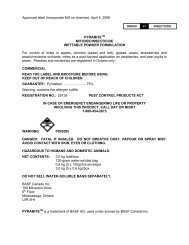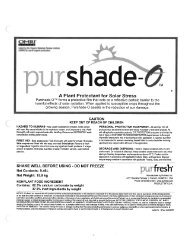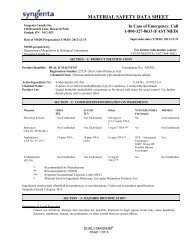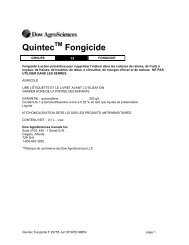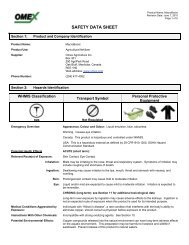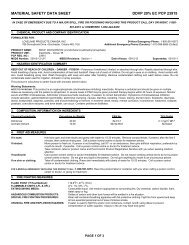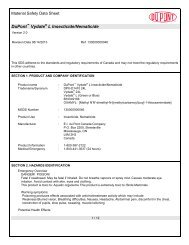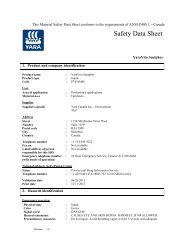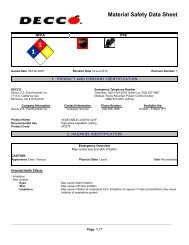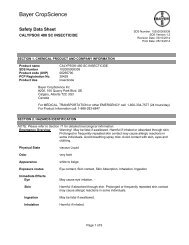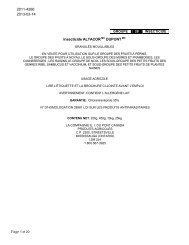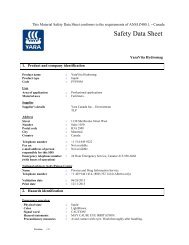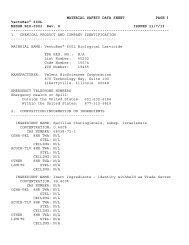Tanos 50DF label english.pdf - Bartlett.ca
Tanos 50DF label english.pdf - Bartlett.ca
Tanos 50DF label english.pdf - Bartlett.ca
Create successful ePaper yourself
Turn your PDF publications into a flip-book with our unique Google optimized e-Paper software.
2004-3555<br />
2013-07-11<br />
TANOS® 50 DF FUNGICIDE<br />
DRY FLOWABLE<br />
GROUP 11 27 FUNGICIDE<br />
FOR SALE FOR USE ON POTATOES, FIELD TOMATOES AND CANEBERRIES ONLY<br />
AGRICULTURAL<br />
REGISTRATION NO. 27435 PEST CONTROL PRODUCTS ACT<br />
GUARANTEE: Famoxadone 25%<br />
Cymoxanil 25%<br />
Warning, contains the allergen sulfites.<br />
USE RESTRICTION: Do not apply <strong>Tanos</strong>® 50 DF Fungicide to more than 100 ha per day.<br />
WARNING – POISON<br />
EYE IRRITANT<br />
READ THE LABEL AND ATTACHED BROCHURE BEFORE USING<br />
KEEP OUT OF REACH OF CHILDREN<br />
NET CONTENTS: 2.5-5 kg<br />
E. I. DUPONT CANADA COMPANY<br />
AGRICULTURAL PRODUCTS<br />
P.O. BOX 2300, STREETSVILLE<br />
MISSISSAUGA, ONTARIO L5M 2J4<br />
1-800-667-3925<br />
Page 1 of 11
PRECAUTIONS:<br />
• KEEP OUT OF REACH OF CHILDREN<br />
• Harmful or fatal if swallowed.<br />
• Avoid contact with food, drink and livestock feed material.<br />
• May irritate eyes. Avoid contact with eyes.<br />
• Avoid contact with skin, eyes or clothing.<br />
• Wash thoroughly with soap and water after handling.<br />
• Wear chemi<strong>ca</strong>l resistant coveralls over long-sleeved shirt and long pants, goggles or<br />
face shield and chemi<strong>ca</strong>l resistant gloves during mixing, loading, appli<strong>ca</strong>tion, cleanup<br />
and repair.<br />
• Remove contaminated clothing and wash clothing before reuse.<br />
• For potatoes: Do not enter or allow worker entry into treated areas during the restricted<br />
entry interval (REI) of 24 hours. For field tomatoes: Do not enter or allow worker entry<br />
into treated areas during the restricted entry interval (REI) of 12 hours. For <strong>ca</strong>neberries:<br />
Do not enter or allow worker entry into treated areas during the restricted entry interval<br />
(REI) of 9 days.<br />
If this pest control product is to be used on a commodity that may be exported to the U.S. and<br />
you require information on acceptable residue levels in the U.S., visit CropLife Canada’s web<br />
site at www.croplife.<strong>ca</strong><br />
FIRST AID:<br />
IF IN EYES: Hold eye open and rinse slowly and gently with water for 15-20 minutes. Remove<br />
contact lenses, if present, after the first 5 minutes, then continue rinsing eye. Call a poison<br />
control centre or doctor for treatment advice.<br />
IF ON SKIN OR CLOTHING: Take off contaminated clothing. Rinse skin immediately with<br />
plenty of water for 15-20 minutes. Call a poison control centre or doctor for treatment advice.<br />
IF SWALLOWED: Call a poison control centre or doctor immediately for treatment advice.<br />
Have person sip a glass of water if able to swallow. Do not induce vomiting unless told to do so<br />
by a poison control centre or doctor. Do not give anything by mouth to an unconscious person.<br />
IF INHALED: Mover person to fresh air. If person is not breathing, <strong>ca</strong>ll 911 or an ambulance,<br />
then give artificial respiration, preferably by mouth-to-mouth, if possible. Call a poison control<br />
centre or doctor for further treatment advice.<br />
Take container, <strong>label</strong> or product name and Pest Control Product Registration Number with you<br />
when seeking medi<strong>ca</strong>l attention.<br />
For medi<strong>ca</strong>l emergencies <strong>ca</strong>ll 1-800-441-3637 (24 hours).<br />
TOXICOLOGICAL INFORMATION: Treat Symptomati<strong>ca</strong>lly.<br />
Page 2 of 11
ENVIRONMENTAL HAZARDS<br />
1. Toxic to fish and other aquatic organisms. Observe buffer zones specified in the booklet<br />
under Use Rates and Appli<strong>ca</strong>tion Instructions.<br />
2. This product is toxic to birds and wild mammals, and is harmful to beneficial arthropods,<br />
such as predators and parasitoids.<br />
3. The best available technique which minimizes off-target drift, should be used to reduce<br />
effects on wildlife in field boundary.<br />
4. Do not apply to areas that are vulnerable to runoff. If rainfall is imminent, delay spraying.<br />
STORAGE:<br />
Store product closed in original container only. Protect against humid air and water. Not for use<br />
or storage in or around the home. Do not contaminate water, other pesticides, fertilizer, food or<br />
feed in storage. Keep container tightly closed<br />
DISPOSAL:<br />
Do not reuse this container for any purpose. This is a recyclable container and is to be disposed<br />
of at a container collection site. Contact your lo<strong>ca</strong>l distributor/dealer or municipality for the<br />
lo<strong>ca</strong>tion of the nearest collection site. Before taking the container to the collection site:<br />
1. Triple- or pressure-rinse the empty container. Add the rinsings to the spray mixture in the<br />
tank.<br />
2. Make the empty, rinsed container unsuitable for further use.<br />
If there is no container collection site in your area, dispose of the container in accordance with<br />
provincial requirements.<br />
For information on the disposal of the unused, unwanted product, contact the manufacturer or the<br />
provincial regulatory agency. Contact the manufacturer and the provincial regulatory agency in<br />
<strong>ca</strong>se of a spill, and for clean-up of spills.<br />
NOTICE TO USER:<br />
This pest control product is to be used only in accordance with the directions on the <strong>label</strong>. It is an<br />
offence under the Pest Control Products Act to use this product in a way that is inconsistent with<br />
the directions on the <strong>label</strong>. The user assumes the risk to persons or property that arises from any<br />
such use of this product.<br />
The seller warrants that the purchase by the buyer and the use of this product, as such, will not<br />
infringe any Canadian patent.<br />
Page 3 of 11
TANOS® 50 DF FUNGICIDE<br />
DRY FLOWABLE<br />
GROUP 11 27 FUNGICIDE<br />
FOR SALE FOR USE ON POTATOES, FIELD TOMATOES AND CANEBERRIES ONLY<br />
AGRICULTURAL<br />
REGISTRATION NO. 27435 PEST CONTROL PRODUCTS ACT<br />
GUARANTEE: Famoxadone 25%<br />
Cymoxanil 25%<br />
Warning, contains the allergen sulfites.<br />
USE RESTRICTION: Do not apply <strong>Tanos</strong>® 50 DF Fungicide to more than 100 ha per day.<br />
WARNING – POISON<br />
EYE IRRITANT<br />
READ THE LABEL AND ATTACHED BROCHURE BEFORE USING<br />
KEEP OUT OF REACH OF CHILDREN<br />
NET CONTENTS: 2.5-5 kg<br />
E. I. DUPONT CANADA COMPANY<br />
AGRICULTURAL PRODUCTS<br />
P.O. BOX 2300, STREETSVILLE<br />
MISSISSAUGA, ONTARIO L5M 2J4<br />
1-800-667-3925<br />
PRECAUTIONS:<br />
• KEEP OUT OF REACH OF CHILDREN<br />
• Harmful or fatal if swallowed.<br />
• Avoid contact with food, drink and livestock feed material.<br />
• May irritate eyes. Avoid contact with eyes.<br />
Page 4 of 11
• Avoid contact with skin, eyes or clothing.<br />
• Wash thoroughly with soap and water after handling.<br />
• Wear chemi<strong>ca</strong>l resistant coveralls over long-sleeved shirt and long pants, goggles or<br />
face shield and chemi<strong>ca</strong>l resistant gloves during mixing, loading, appli<strong>ca</strong>tion, cleanup<br />
and repair.<br />
• Remove contaminated clothing and wash clothing before reuse.<br />
• For potatoes: Do not enter or allow worker entry into treated areas during the restricted<br />
entry interval (REI) of 24 hours. For field tomatoes: Do not enter or allow worker entry<br />
into treated areas during the restricted entry interval (REI) of 12 hours. For <strong>ca</strong>neberries:<br />
Do not enter or allow worker entry into treated areas during the restricted entry interval<br />
(REI) of 9 days.<br />
If this pest control product is to be used on a commodity that may be exported to the U.S. and<br />
you require information on acceptable residue levels in the U.S., visit CropLife Canada’s web<br />
site at www.croplife.<strong>ca</strong><br />
FIRST AID:<br />
IF IN EYES: Hold eye open and rinse slowly and gently with water for 15-20 minutes. Remove<br />
contact lenses, if present, after the first 5 minutes, then continue rinsing eye. Call a poison<br />
control centre or doctor for treatment advice.<br />
IF ON SKIN OR CLOTHING: Take off contaminated clothing. Rinse skin immediately with<br />
plenty of water for 15-20 minutes. Call a poison control centre or doctor for treatment advice.<br />
IF SWALLOWED: Call a poison control centre or doctor immediately for treatment advice.<br />
Have person sip a glass of water if able to swallow. Do not induce vomiting unless told to do so<br />
by a poison control centre or doctor. Do not give anything by mouth to an unconscious person.<br />
IF INHALED: Mover person to fresh air. If person is not breathing, <strong>ca</strong>ll 911 or an ambulance,<br />
then give artificial respiration, preferably by mouth-to-mouth, if possible. Call a poison control<br />
centre or doctor for further treatment advice.<br />
Take container, <strong>label</strong> or product name and Pest Control Product Registration Number with you<br />
when seeking medi<strong>ca</strong>l attention.<br />
For medi<strong>ca</strong>l emergencies <strong>ca</strong>ll 1-800-441-3637 (24 hours).<br />
TOXICOLOGICAL INFORMATION: Treat Symptomati<strong>ca</strong>lly.<br />
ENVIRONMENTAL HAZARDS<br />
1. Toxic to fish and other aquatic organisms. Observe buffer zones specified in the booklet<br />
under Use Rates and Appli<strong>ca</strong>tion Instructions.<br />
2. This product is toxic to birds and wild mammals, and is harmful to beneficial arthropods,<br />
such as predators and parasitoids.<br />
Page 5 of 11
3. The best available technique which minimizes off-target drift, should be used to reduce<br />
effects on wildlife in field boundary.<br />
4. Do not apply to areas that are vulnerable to runoff. If rainfall is imminent, delay spraying.<br />
DIRECTIONS FOR USE<br />
GENERAL INFORMATION<br />
TANOS® 50 DF Fungicide is a protectant and lo<strong>ca</strong>lly systemic fungicide recommended for use<br />
as a spray, for the control of early and late blight on potatoes and field tomatoes.<br />
Apply as a spray with ground or air assisted equipment, except as otherwise directed, using<br />
sufficient water to obtain thorough coverage of plants.<br />
Do not apply TANOS® 50 DF Fungicide to more than 100 ha/day.<br />
DO NOT APPLY BY AIR.<br />
DO NOT USE ON GREENHOUSE TOMATOES.<br />
Not for use in home plantings nor once any commercial crop is turned into U-pick, Pick-Your-<br />
Own or similar operation.<br />
CROP SAFETY AND VARIETAL SENSITIVITY:<br />
TANOS® 50 DF Fungicide must not be applied to any crop suffering from stress as a result of<br />
drought, water logging, low temperatures, insect attacks, nutrient or lime deficiency or other<br />
factors reducing crop growth.<br />
INTEGRATED PEST MANAGEMENT:<br />
DuPont recommends the use of Integrated Pest Management (IPM) programs to control pests.<br />
This product may be used as part of an integrated Pest Management (IPM) program, which <strong>ca</strong>n<br />
include biologi<strong>ca</strong>l, cultural, and genetic practices, aimed at preventing economic pest damage.<br />
Appli<strong>ca</strong>tion of this product should be based on IPM principles and practices including field<br />
scouting or other detection methods, correct target pest identifi<strong>ca</strong>tion, population monitoring, and<br />
treating when blight fore<strong>ca</strong>sting models reach lo<strong>ca</strong>lly determined action levels. Consult your<br />
provincial extension service, professional consultants or other qualified authorities to determine<br />
the appropriate management, cultural practice and treatment threshold levels for the specific<br />
crop, geography and diseases.<br />
RESISTANCE MANAGEMENT:<br />
For resistance management, TANOS® 50 DF Fungicide is a group 11 and 27 (famoxadone and<br />
cymoxanil) fungicide. Any fungal population may contain individuals naturally resistant to<br />
TANOS® 50 DF Fungicide and other group 11 and/or 27 fungicides. The resistant biotypes may<br />
dominate the fungal population if these fungicides are used repeatedly in the same field. Other<br />
resistance mechanisms that are not linked to site of action, but specific for individual chemi<strong>ca</strong>ls,<br />
Page 6 of 11
such as enhanced metabolism, may also exist. Appropriate resistance-management strategies<br />
should be followed.<br />
To delay fungicide resistance:<br />
♦ Alternate with fungicides having a different mode of action other than group 11 and 27<br />
after each appli<strong>ca</strong>tion of TANOS® 50 DF Fungicide.<br />
♦ A maximum of three appli<strong>ca</strong>tions per year<br />
♦ Fungicide use should be based on an IPM program that includes scouting, record<br />
keeping, and considers cultural, biologi<strong>ca</strong>l and other chemi<strong>ca</strong>l control practices.<br />
♦ Monitor effi<strong>ca</strong>cy of all fungicides used in disease management program against the<br />
target pathogen and record other factors that may influence fungicide performance<br />
and/or disease development.<br />
♦ Contact your lo<strong>ca</strong>l extension specialist or certified crop advisors for any additional<br />
pesticide resistance-management and IPM recommendations for specific site and pest<br />
problems in the area.<br />
♦ For further information or to report suspected resistance, contact your lo<strong>ca</strong>l E. I du Pont<br />
Canada Company representative or the E. I. du Pont Canada Company hotline at 1-800-<br />
667-3925 for further information<br />
APPLICATION INFORMATION<br />
PESTICIDE HANDLING:<br />
• Calibrate sprayers only with clean water away from the well site.<br />
• Make scheduled checks of spray equipment.<br />
• Ensure accurate measurement of pesticides by all operation employees.<br />
• Mix only enough product for the job at hand.<br />
• Avoid overfilling of spray tank.<br />
• Do not discharge excess material on the soil at a single spot in the field/grove or<br />
mixing/loading station.<br />
• Dilute and agitate excess solution and apply at <strong>label</strong>led rates/uses.<br />
• Do not store pesticides near well sites.<br />
• When triple rinsing the pesticide container, ensure the rinsate is added to the spray mix.<br />
MIXING INSTRUCTIONS:<br />
1. Fill the tank 1/4 to 1/3 full of water.<br />
2. While agitating, add the required amount of TANOS® 50 DF Fungicide.<br />
3. Continue agitation until the TANOS® 50 DF Fungicide is fully dispersed, at least 5<br />
minutes.<br />
4. Once the TANOS® 50 DF Fungicide is fully dispersed, maintain agitation and continue<br />
filling tank with water. TANOS® 50 DF Fungicide should be thoroughly mixed with water<br />
before adding any other material.<br />
5. If the mixture is not continuously agitated, settling will occur. If settling occurs, thoroughly<br />
reagitate before using.<br />
6. Apply TANOS® 50 DF Fungicide spray mixture within 12 hours of mixing to avoid<br />
product degradation.<br />
Page 7 of 11
CROP ROTATION RESTRICTIONS:<br />
Crops that are on the TANOS® 50 DF Fungicide <strong>label</strong> may be planted back at any time; cereal<br />
grains may be planted back following a minimum plantback interval of 30 days; and all other<br />
crops may be planted back following a minimum plantback interval of one year.<br />
COMPATIBILITY:<br />
Since formulations may be changed and new ones introduced, it is recommended that users<br />
premix a small quantity of a desired tank mix and observe for possible adverse changes (settling<br />
out, flocculation, etc.). Avoid mixtures of several materials and very concentrated spray<br />
mixtures.<br />
Tank mix solutions containing boron may affect solubility of the product. When using boron<br />
containing solutions in a tank mix, follow these procedures:<br />
- Add the correct amount to TANOS® 50 DF Fungicide first<br />
- Introduce boron containing solutions last<br />
APPLICATION TIMINGS:<br />
• Make the first appli<strong>ca</strong>tion of TANOS® 50 DF Fungicide following one to two<br />
appli<strong>ca</strong>tions of a preventative broad spectrum fungicide such as chlorothalonil or<br />
mancozeb.<br />
• Make the second appli<strong>ca</strong>tion no less than 12 days after the first; a third appli<strong>ca</strong>tion may<br />
be made no less than 24 days after the second.<br />
• Apply TANOS® 50 DF Fungicide in a preventative program.<br />
• When using TANOS® 50 DF Fungicide in a fungicide program, a recommendation is to<br />
alternate with other fungicides to manage resistance.<br />
• Utilize sufficient water to obtain thorough coverage.<br />
• Ground - Conventional - no less than 250 - 300 l/ha<br />
- Air assisted - no less than 110 l/ha<br />
RAINFASTNESS:<br />
TANOS® 50 DF Fungicide rapidly penetrates into plant tissues and is rainfast within 12 hours<br />
after appli<strong>ca</strong>tion.<br />
Page 8 of 11
USE RATES AND APPLICATION INSTRUCTIONS:<br />
Crop Disease Rate<br />
(g/ha)<br />
Spray Interval<br />
potato<br />
field<br />
tomato<br />
early blight<br />
(Alternaria solani)<br />
late blight<br />
(Phytophthora<br />
infestans)<br />
PHI = preharvest interval<br />
REI = restricted entry interval<br />
560 - 840 A minimum 12 day<br />
appli<strong>ca</strong>tion interval must<br />
pass between the 1st and 2nd<br />
Maximum<br />
No.<br />
Appli<strong>ca</strong>tions<br />
per year<br />
PHI<br />
(days)<br />
REI<br />
(hours)<br />
3 14 24<br />
560 appli<strong>ca</strong>tion of TANOS® 50<br />
DF Fungicide. A minimum<br />
24 day appli<strong>ca</strong>tion interval<br />
must pass between the 2nd<br />
and 3rd appli<strong>ca</strong>tion of<br />
TANOS® <strong>50DF</strong>.<br />
Fungicides other than<br />
TANOS® <strong>50DF</strong> may be<br />
used as necessary to protect<br />
the crop during these<br />
intervals.<br />
3 12<br />
Do not apply during periods of dead <strong>ca</strong>lm or when winds are gusty.<br />
Toxic to fish and other aquatic organisms. Overspray or drift to sensitive habitats must be<br />
avoided. A buffer zone of 44 meters is required between the downwind point of direct<br />
appli<strong>ca</strong>tion and the closest edge of sensitive aquatic habitats such as lakes, rivers, sloughs, ponds,<br />
coulees, prairie potholes, creeks, marshes, streams, reservoirs, and wetlands. A buffer zone of 23<br />
meters is required between the downwind point of direct appli<strong>ca</strong>tion and the closest edge of<br />
estuarine/marine habitats. Do not contaminate these habitats when cleaning and rinsing spray<br />
equipment or containers.<br />
A maximum of 3 appli<strong>ca</strong>tions per year is recommended for resistance management. Alternate<br />
with fungicides having a different mode of action other than group 11 and 27 after each<br />
appli<strong>ca</strong>tion of TANOS® 50 DF Fungicide. Use ground appli<strong>ca</strong>tion only.<br />
NOTE TO USER: READ THE FOLLOWING BEFORE USING THIS PRODUCT FOR<br />
THE INDICATED SPECIAL USE APPLICATIONS:<br />
The DIRECTIONS FOR USE for this product for the uses described below were developed by<br />
persons other than The E. I. du Pont Canada Company and accepted for registration by Health<br />
Canada under the User Requested Minor Use Label Expansion program. The E. I. du Pont<br />
Canada Company itself makes no representation or warranty with respect to product performance<br />
(effi<strong>ca</strong>cy) and crop tolerance (phytotoxicity) claims for this product when used on the crops<br />
listed below. Accordingly, the Buyer and User assume all risks related to performance and crop<br />
tolerance arising, and agree to hold The E. I. du Pont Canada Company harmless from any<br />
claims based on effi<strong>ca</strong>cy or phytotoxicity in connection with the uses described below.<br />
Page 9 of 11
FOR USE ON CANEBERRIES (including blackberry; raspberry, red and black; wild raspberry;<br />
loganberry; cultivars and hybrids of these.):<br />
For control of Caneberry Spur blight (Dydimella applanata ), <strong>ca</strong>ne botrytis (Botrytis cinerea ),<br />
Caneberry anthracnose (Elsinoe veneta ), and preharvest fruit rot (Botrytis cinerea ), apply<br />
<strong>Tanos</strong>® 50 DF Fungicide at the rate of 840 grams/hectare. Use a sufficient water volume to<br />
ensure thorough coverage of the crop (250-800 L/ha)<br />
Apply to foliage and fruit. A minimum 12 day appli<strong>ca</strong>tion interval must pass between the 1st and<br />
2nd appli<strong>ca</strong>tion of TANOS® 50 DF Fungicide. A minimum 24 day appli<strong>ca</strong>tion interval must<br />
pass between the 2nd and 3rd appli<strong>ca</strong>tion of TANOS® <strong>50DF</strong> Fungicide.<br />
Make no more than 3 appli<strong>ca</strong>tions per year.<br />
Preharvest interval is 9 days.<br />
Restricted entry interval is 9 days.<br />
Use ground equipment only.<br />
Refer to other sections of this <strong>label</strong> for additional appli<strong>ca</strong>tion instructions and/or use pre<strong>ca</strong>utions.<br />
SPRAY DRIFT MANAGEMENT:<br />
The interaction of many equipment and weather-related factors determines the potential for spray<br />
drift. The appli<strong>ca</strong>tor is responsible for considering all these factors when making appli<strong>ca</strong>tion<br />
decisions.<br />
AVOIDING SPRAY DRIFT IS THE RESPONSIBILITY OF THE APPLICATOR.<br />
APPLYING LARGER DROPLETS REDUCES DRIFT POTENTIAL, BUT WILL NOT<br />
PREVENT DRIFT IF APPLICATIONS ARE MADE IMPROPERLY OR UNDER<br />
UNFAVOURABLE ENVIRONMENTAL CONDITIONS<br />
The most effective way to reduce drift potential is to apply large droplets. The best drift<br />
management strategy is to apply the largest droplets that provide sufficient coverage and control.<br />
The presence of sensitive species nearby, the environmental conditions, and pest pressure may<br />
affect how an appli<strong>ca</strong>tor balances drift control and coverage.<br />
Important factors to consider when trying to minimize the potential for spray drift are:<br />
a) droplet size (spray volume, pressure and nozzle type)<br />
b) boom height (minimized above crop)<br />
c) wind (spray between wind speeds of 5 to 15 kilometres per hour)<br />
d) temperature and humidity (large droplets reduce evaporation).<br />
Page 10 of 11
SPRAY TANK CLEANOUT:<br />
Prior to appli<strong>ca</strong>tion, start with clean, well maintained appli<strong>ca</strong>tion equipment. Immediately<br />
following appli<strong>ca</strong>tion, thoroughly clean all spray equipment to reduce the risk of forming<br />
hardened deposits which might become difficult to remove.<br />
Drain spray equipment. Thoroughly rinse sprayer and flush hoses, boom and nozzles with clean<br />
water. Clean all other associated appli<strong>ca</strong>tion equipment. Take all necessary safety pre<strong>ca</strong>utions<br />
when cleaning equipment. Do not clean near wells, water sources or desirable vegetation.<br />
Dispose of waste rinse water by applying to a portion of the treated field.<br />
STORAGE:<br />
Store product closed in original container only. Protect against humid air and water. Not for use<br />
or storage in or around the home. Do not contaminate water, other pesticides, fertilizer, food or<br />
feed in storage. Keep container tightly closed.<br />
DISPOSAL:<br />
Do not reuse this container for any purpose. This is a recyclable container and is to be disposed<br />
of at a container collection site. Contact your lo<strong>ca</strong>l distributor/dealer or municipality for the<br />
lo<strong>ca</strong>tion of the nearest collection site. Before taking the container to the collection site:<br />
1. Triple- or pressure-rinse the empty container. Add the rinsings to the spray mixture in the<br />
tank.<br />
2. Make the empty, rinsed container unsuitable for further use.<br />
If there is no container collection site in your area, dispose of the container in accordance with<br />
provincial requirements.<br />
For information on the disposal of the unused, unwanted product, contact the manufacturer or the<br />
provincial regulatory agency. Contact the manufacturer and the provincial regulatory agency in<br />
<strong>ca</strong>se of a spill, and for clean-up of spills.<br />
NOTICE TO USER:<br />
This pest control product is to be used only in accordance with the directions on the <strong>label</strong>. It is an<br />
offence under the Pest Control Products Act to use this product in a way that is inconsistent with<br />
the directions on the <strong>label</strong>. The user assumes the risk to persons or property that arises from any<br />
such use of this product.<br />
The seller warrants that the purchase by the buyer and the use of this product, as such, will not<br />
infringe any Canadian patent.<br />
®/tm Registered trademarks/trademarks of E.I. du Pont Company. E. I. du Pont Canada<br />
Company is a licensee. Member of CropLife.<br />
Page 11 of 11



